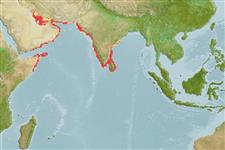Common names from other countries
Elasmobranchii (hajar och rockor) (sharks and rays) >
Carcharhiniformes (Ground sharks) >
Carcharhinidae (Requiem sharks)
Etymology: Carcharhinus: karcharos (Gr.), sharp or jagged; rhinus, an ancient name for sharks, from rhine (Gr.), rasp, both words alluding to a shark's jagged, rasp-like skin. (See ETYFish); dussumieri: In honor of Jean-Jacques Dussumier (1792-1883), French voyager and merchant, who collected some of the type material off Bombay (Mumbai) [authorship often attributed to Müller & Henle, who published Valenciennes’ description]. (See ETYFish).
Environment: milieu / climate zone / depth range / distribution range
Ekologi
marina revassocierade; djupintervall 0 - 100 m (Ref. 106604). Tropical; 30°N - 5°N, 49°E - 84°E
Indian Ocean: from at least the Persian Gulf to India. Complete distributional range is unknown.
Length at first maturity / Size / Vikt / Age
Maturity: Lm 68.3, range 60 - 75 cm
Max length : 121 cm TL hane/ej könsbestämd; (Ref. 114871)
Ryggkotor: 113 - 129. This small species is distinguished by the following characters: snout relatively long and narrowly rounded to almost pointed; upper anterior teeth are oblique and blade-like, coarsely serrated, with lateral margin deeply notched and with several large and serrated basal cusplets; lower anterior teeth are narrower, slightly oblique, lateral margins notched and usually without large basal serrae, finely serrated; total tooth row counts 27-29/24-30, or 52-59; interdorsal space often without a ridge, 17.9-20.8% TL; first dorsal fin relatively low and not falcate, origin over middle of pectoral-fin inner margin, length 14.3-16.2% TL, 1.4-1.6 times height, inner margin 2.2-2.5 in base; second dorsal fin is much smaller, broadly triangular, height 32-37% of first dorsal-fin height, origin about opposite anal fin origin; anal fin is slightly falcate, height 1.0-1.2 times second dorsal-fin height, base 0.9-1.1 times second dorsal fin base; body colour pale brownish dorsally, whitish ventrally; second dorsal fin with a black blotch on upper third of fin, not extending onto upper surface of body and very well defined from ground colour, while other fins mostly plain; total vertebral counts 123-138; monospondylous precaudal counts 42-48; diplospondylous precaudal counts 20; diplospondylous caudal counts 59-70; precaudal counts 62-68 (Ref. 89954).
A common but little-known shark found on the continental and insular inshore areas (Ref. 9997). Feeds mainly on fishes but also on cephalopods, and crustaceans (Ref. 6871). Viviparous (Ref. 50449), with a yolk-sac placenta; gives birth to litters of 1-4 (usually 2) pups (Ref. 58048). Pregnant females (79-100.7 cm TL) that were caught contained 2-5 late-term embryos between 32-38.7 cm TL, thus birth size is presumed to be around 37-39 cm TL. From more than 1000 market specimens (in Kuwait, Qatar and Abu Dhabi), size of males and females range from 36-85 cm TL and 36-100.7 cm TL, respectively, with males reaching maturity between 63-80 cm TL (Ref. 89954). Taken in artisanal and small-scale commercial fisheries and marketed for human consumption (Ref. 244). Fins also utilized (Ref. 6871).
Viviparous, placental (Ref. 50449). With 2 to 4 pups in a litter; 37-38 cm at birth (Ref. 244). Both male and females mature at about 70 cm (Ref. 6871). Distinct pairing with embrace (Ref. 205). No distinct seasonal reproductive cycle apparent, instead continuously breeding with most mature females pregnant or spent at any one time (Ref.58048).
White, W.T., 2012. A redescription of Carcharhinus dussumieri and C. sealei, with resurrection of C. coatesi and C. tjutjot as valid species (Chondrichthyes: Carcharhinidae). Zootaxa 3241:1-34. (Ref. 89954)
IUCN Red List Status (Ref. 130435)
Human uses
Fiskeri: kommersiell
Verktyg
Special reports
Download XML
Internet-källor
Estimates based on models
Preferred temperature (Ref.
115969): 24.2 - 28.5, mean 27.1 (based on 230 cells).
Phylogenetic diversity index (Ref.
82804): PD
50 = 0.5000 [Uniqueness, from 0.5 = low to 2.0 = high].
Bayesian length-weight: a=0.00324 (0.00210 - 0.00498), b=3.09 (2.97 - 3.21), in cm Total Length, based on LWR estimates for this species & Genus-body shape (Ref.
93245).
Trofisk nivå (Ref.
69278): 3.9 ±0.0 se; based on diet studies.
Resiliens (Ref.
120179): Mycket låg, lägsta populationsfördubblingstid mer än 14 år (Fec=2).
Fishing Vulnerability (Ref.
59153): High vulnerability (56 of 100).
